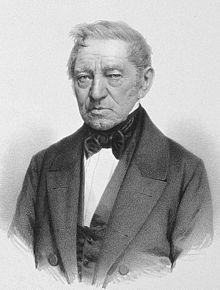Hinrich Lichtenstein
Hinrich Lichtenstein | |
|---|---|
 | |
| Born | Hinrich Lichtenstein 10 January 1780 |
| Died | 2 September 1857 (aged 77) |
Martin H[e]inrich Carl Lichtenstein (10 January 1780 – 2 September 1857) was a German
Biography

Born in
Lichtenstein was a close friend of Carl Maria von Weber. After his death, in 1826, together with the banker Wilhelm Beer, he arranged for the sale of the score of Oberon to the Berlin music publisher Adolf Martin Schlesinger on behalf of Weber's widow Caroline. As guardian together with Carl Theodor Winkler, he participated in the education of Weber's orphaned sons Max Maria and Alexander.[3][4]
In 1829, Lichtenstein was elected a foreign member of the Royal Swedish Academy of Sciences. He was also appointed Privy Councillor in Berlin. He died from a stroke at sea while aboard a steamer from Korsør to Kiel.[5]
Legacy
Lichtenstein was responsible for the creation of
In the field of
Among species named by Lichtenstein are the Australian king parrot (Alisterus scapularis), the crowned sandgrouse (Pterocles coronatus), and the Cape night adder (Causus rhombeatus).
In 1826, botanists
In 1856
Then in 1859 Italian
Writings
Lichtenstein's Reisen im südlichen Afrika in den Jahren 1803, 1804, 1805 und 1806 was translated into English by Anne Plumptre, and published in 1812 as "Travels in Southern Africa in the years 1803, 1804, 1805 and 1806".[12]
- Reisen im südlichen Afrika. 1803–1806. Mit einer Einführung von Wahrhold Drascher. 1811. 2 Bände (Neudruck: Brockhaus Antiquarium, Stuttgart 1967).
- Nachrichten von Teneriffa. Ein Fragment aus dem Tagebuche des Hrn. Dr. Lichtenstein auf der Reise von Amsterdam nach dem Vorgebirge der guten Hofnung 1802. Industrie-Comptoirs, Weimar 1806
- Über die Beetjuanas. Als Nachtrag und Berichtigung zu Barrows Auszug aus Trüters Tagebuch einer Reise zu den Buschwanas. Vom Hrn. Dr. Hinrich Lichtenstein. Industrie-Comptoirs, Weimar 1807
- Darstellung neuer oder wenig bekannter Säugethiere in Abbildungen und Beschreibungen von 65 Arten auf 50 colorirten Steindrucktafeln, nach den Originalen des Zoologischen Museums der Universität Berlin. Lüderitz, Berlin 1827/34. Text Plates
- Zur Geschichte der Sing-Akademie in Berlin. Nebst einer Nachricht über das Fest am funfzigsten Jahrestage Ihrer Stiftung und einem alphabetischen Verzeichniss aller Personen, die ihr als Mitglieder angehört haben. Verlag Trautwein, Berlin 1843.
Literature
- Ernst Rudorff (Hrsg.): Briefe von Carl Maria von Weber an Hinrich Lichtenstein. Mit drei Porträts, drei Abbildungen und sechs Faksimiles. George Westermann, Braunschweig 1900. VIII Seiten, 252 Seiten, mit Abb.
- Wilhelm Bölsche (Hrsg.): Neue Welten. Die Eroberung der Erde in Darstellungen großer Naturforscher. Anthologie mit Texten von Georg Forster, Hinrich Lichtenstein, Karl von den Steinen, Ferdinand von Hochstetter, Alfred Russel Wallace, Adelbert von Chamisso, Alexander von Humboldt und Charles Darwin – jeweils mit Einleitung von Wilhelm Bölsche. EA. Deutsche Bibliothek, Berlin 1917. XXIV, 644 S., 1 Bl. Mit 24 Tafeln.
- F.D. Steinheimer, 2008 Martin Hinrich Carl Lichtenstein and his ornithological purchases at the auction of William Bullock's museum in 1819 Archives of Natural History, Volume 35 Issue 1, Page 88–99, ISSN 0260-9541
References
- ^ Näf-Gloor, Sandra (2019). "3 A naturalist's career. Hinrich Lichtenstein (1780–1857)". In Lengwiler, Martin; Penn, Nigel; Harries, Patrick (eds.). Science, Africa and Europe. Processing Information and Creating Knowledge. Routledge. pp. 47–65.
- ISSN 0260-9541.
- ^ "Brief von Caroline von Weber an Hinrich Lichtenstein vom 21. Juni 1826".
- ^ "Hofrath Karl Theodor Winkler zum Vormunde verordnet".
- ^ Naumannia: Archiv für die Ornithologie Vorzugsweise Europa's : Organ der Deutsche Ornithologen-Gesellschaft.
- ^ "Lichtenstein". Amphibian Species of the World 5.5. research.amnh.org/vz/herpetology.amphibia.
- ^ "Lichtenstein". The Reptile Database. www.reptile-database.org.
- ^ "Lichtensteinia Cham. & Schltdl. | Plants of the World Online | Kew Science". Plants of the World Online. Retrieved 16 May 2021.
- JSTOR 4119540.
- ^ Christopher Scharpf & Kenneth J. Lazara (22 September 2018). "Order SYNGNATHIFORMES: Families AULOSTOMIDAE, CENTRISCIDAE, FISTULARIIDAE, SOLENOSTOMIDAE and SYNGNATHIDAE". The ETYFish Project Fish Name Etymology Database. Christopher Scharpf and Kenneth J. Lazara. Retrieved 9 December 2021.
- ISBN 978-1-4214-0135-5.
- ^ IDREF.fr (bibliography)
- ^ International Plant Names Index. Licht.
Other sources
- New International Encyclopedia(1st ed.). New York: Dodd, Mead.
External links
- Travels in southern Africa in the years 1803, 1804, 1805 and 1806 (English translation, 1812) Volume 1 Volume 2
- Nomenclator avium Musei zoologici berolinensis: Namenverzeichniss der in der zoologischen Sammlung der Königlichen Universität zu Berlin (1854)
